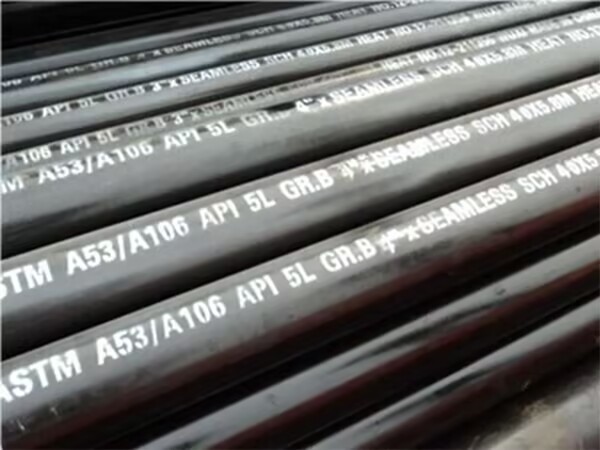
Schedule 40 steel pipes are standard steel pipes classified by nominal pipe size (NPS) and wall thickness. Their wall thickness is directly related to their nominal size (e.g. 1/4 inch to 20 inches). The thickness varies from 0.068 inches (1.73 mm) at the thinnest to 0.406 inches (10.31 mm) at the thickest. The standard thickness of pipe wall thickness makes Schedule 40 pipe suitable for a variety of applications, such as building construction, liquid transportation, and low pressure gas transportation. When manufactured, Schedule 40 steel pipes can be customized according to actual needs.
Schedule 40 Pipe size chart, dimensions, wall thickness and weight:
|
Nominal size [inches] |
Outside diameter [inches] |
Outside diameter [mm] |
Wall thickness [inches] |
Wall thickness [mm] |
Weight [lb/ft] |
Weight [kg/m] |
|
1/8 inches |
0.405 inches |
10.3 MM |
0.068 inches |
1.73 MM |
0.24 lb/ft |
0.37 kg/m |
|
1/4 inches |
0.540 inches |
13.7 MM |
0.088 inches |
2.24 MM |
0.42 lb/ft |
0.84 kg/m |
|
1/2 inches |
0.840 inches |
21.3 MM |
0.109 inches |
2.77 MM |
0.85 lb/ft |
1.27 kg/m |
|
3/4 inches |
1.050 inches |
26.7 MM |
0.113 inches |
2.87 MM |
1.13 lb/ft |
1.69 kg/m |
|
1 inches |
1.315 inches |
33.4 MM |
0.133 inches |
3.38 MM |
1.68 lb/ft |
2.50 kg/m |
|
1 1/4 inches |
1.660 inches |
42.2 MM |
0.140 inches |
3.56 MM |
2.27 lb/ft |
3.39 kg/m |
|
1 1/2 inches |
1.900 inches |
48.3 MM |
0.145 inches |
3.68 MM |
2.72 lb/ft |
4.05 kg/m |
|
2 inches |
2.375 inches |
60.3 MM |
0.154 inches |
3.91 MM |
3.65 lb/ft |
5.44 kg/m |
|
2 1/2 inches |
2.875 inches |
73.0 MM |
0.203 inches |
5.16 MM |
5.79 lb/ft |
8.63 kg/m |
|
3 inches |
3.500 inches |
88.9 MM |
0.216 inches |
5.49 MM |
7.58 lb/ft |
11.29 kg/m |
|
3 1/2 inches |
4.000 inches |
101.6 MM |
0.226 inches |
5.74 MM |
9.11 lb/ft |
13.57 kg/m |
|
4 inches |
4.500 inches |
114.3 MM |
0.237 inches |
6.02 MM |
10.79 lb/ft |
16.07 kg/m |
|
5 inches |
5.563 inches |
141.3 MM |
0.258 inches |
6.55 MM |
14.62 lb/ft |
21.77 kg/m |
|
6 inches |
6.625 inches |
168.3 MM |
0.280 inches |
7.11 MM |
18.97 lb/ft |
28.26 kg/m |
|
8 inches |
8.625 inches |
219.1 MM |
0.322 inches |
8.18 MM |
28.55 lb/ft |
42.55 kg/m |
|
10 inches |
10.750 inches |
273.0 MM |
0.365 inches |
9.27 MM |
40.48 lb/ft |
60.31 kg/m |
|
12 inches |
12.750 inches |
323.8 MM |
0.406 inches |
10.31 MM |
53.52 lb/ft |
79.73 kg/m |
|
14 inches |
14 inches |
355.6 MM |
0.375 inches |
11.13 MM |
54.57 lb/ft |
94.55 kg/m |
|
16 inches |
16 inches |
406.4 MM |
0.500 inches |
12.70 MM |
82.77 lb/ft |
123.30 kg/m |
|
18 inches |
18 inches |
457.0 MM |
0.562 inches |
14.27 MM |
104.67 lb/ft |
155.80 kg/m |
|
20 inches |
20 inches |
508.0 MM |
0.594 inches |
15.09 MM |
123.11 lb/ft |
183.42 kg/m |
|
24 inches |
24 inches |
610.0 MM |
0.688 inches |
17.48 MM |
171.29 lb/ft |
255.41 kg/m |
|
32 inches |
32 inches |
813.0 MM |
0.688 inches |
17.48 MM |
230.08 lb/ft |
342.91 kg/m |
Mechanical strength:
Schedule 40 carbon steel pipe is available in a number of grades, each with its own unique properties and characteristics, the following are the two most common grades:
ASTM A53 Grade B
Yield Strength: 35000psi (min)
Tensile Strength: 60,00psi (min)
ASTM A106 Grade B
Yield Strength: 35000psi (min)
Tensile Strength: 60,00psi (min)
Chemical composition:
Schedule 40 carbon steel tubes are typically made of mild steel, such as ASTM A53 Grade B steel, which has good corrosion resistance and appropriate mechanical properties. The chemical composition usually includes the following:
Carbon: 0.25% (Max)
Manganese: 0.95% (Max)
Phosphorus: 0.05% (Max)
Sulfur: 0.045% (Max)
Copper: 0.4% (Max)
Nickel: 0.4% (Max)
Chromium: 0.4% (Max)
Molybdenum: 0.15% (Max)
Vanadium: 0.08% (Max)
Application scenario:
1. Due to its rugged properties, Schedule 40 steel pipes are widely used in many fields. Main applications include:
2. Water supply and gas distribution system: As a water supply and gas pipeline, Schedule 40 steel pipes ensure the safe delivery of fluids.
3. Hvac systems: heating, ventilation and air conditioning systems for residential, commercial and industrial buildings.
4. Oil and gas pipelines: widely used in the oil and gas industry to adapt to high temperature and high pressure environment.
5. Chemical processing: Pipelines used to transport acids, alkalis and other corrosive chemicals.
6. Power generation: pipes for conveying high-temperature and high-pressure steam and other fluids.
7. Building structure: Used for structural applications such as building support, scaffolding, fences, etc.
8. Agriculture and mining: transporting water in irrigation systems and mud and other materials in mining environments.